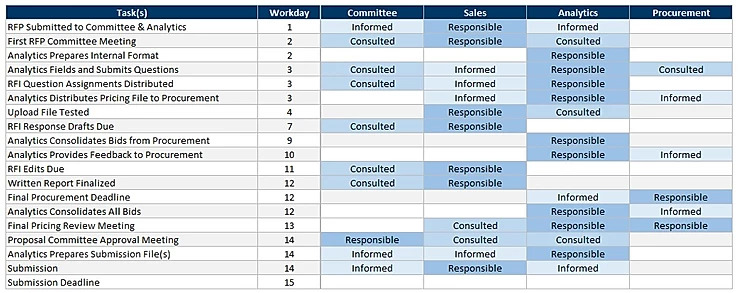So you put your team through the gauntlet of our last post and you’ve decided you want to go after it. You have the right pricing, the right team, and the right value to win an RFP. What next?
RFPs are almost always a trying cross-functional endeavor. One group may spearhead the effort, but effective collaboration and accountability is the ultimate recipe for a timely, effective submission.
At the start of every major bidding event, we all have this utopian vision of interdepartmental cooperation, honored deadlines, and an abundance of time. Unfortunately, reality often has other plans, and managing the internal process somehow becomes more of an undertaking than the RFP itself.
So how do we solve this? After seemingly endless traumatic nights-before and mornings-of, my past organizations implemented an Official RFP Timeline & Accountability Matrix (patent pending).

For the sake of this discussion, we’re going to walk through a business that has a Sales lead on the RFP, an Analytics team managing the RFP internally, a Procurement function, and an established Proposal Committee (typically senior management most impacted by any new business). We’ll also assume we have three weeks from RFP receipt until submission.
First, let’s get all major stakeholders in a room and talk timing and expectations.
The Internal RFP Timeline
1. Sales Submits RFP for Review | 14 Workdays from Submission
We dug pretty deeply here in our last post, but the big takeaway is you shouldn’t automatically go after every RFP. Sales should gather the requisite information and make their case for why it’s an attractive opportunity.
2. Proposal Committee Kickoff | 13 Days Out
After all stakeholders have had a chance to review the RFP requirements, the committee shares their thoughts, approves/declines, and communicates the timeline to the larger team.
3. Analytics Prepares Internal Format | 13 Days Out
Most organizations leverage standard file formats for both the RFI and the pricing portion so they can introduce consistency and automation to the process. For the RFI, this may be as simple as an RFP response library. For the pricing piece, it’s typically a templatized spreadsheet.
4. Analytics Fields and Submits Questions | 12 Days Out
The team quarterbacking the RFP fields and submits any questions to share with the prospect.
5. RFI Question Assignments Distributed | 12 Days Out
The RFI is often a laundry list of questions with varying complexity and relevance. Sales might be most apt to answer some questions, while Marketing some others, etc. Establishing early on who is responsible for which questions and their deadline for internal submission will save all involved from some serious potential headaches.
6. Pricing File Distributed by Procurement | 12 Days Out
The Analytics team has prepared the internal pricing format and received responses to any critical questions. Time to distribute to Procurement.
7. Upload File Tested on Prospect’s System | 11 Days Out
Learn from my mistakes on this one. I can’t tell you how many times we went to submit our beautifully packaged proposal on the day it was due, only to be presented with stomach-turning upload errors. Plug in some sample data and test an upload well before the deadline.
8. RFI Response Drafts Due | 8 Days Out
First deadline for those RFI answers. Gives teams nearly a week to prepare their responses, but still allows plenty of time to review and improve.
9. Analytics Consolidates Bids from Procurement | 6 Days Out
Procurement shares all bids received to date. The Analytics team consolidates and begins to analyze coverage and competitiveness.
10. Analytics Provides Feedback to Procurement | 5 Days Out
Based on their review, Analytics works with Procurement (1) to close any remaining pricing gaps and (2) to improve rates where appropriate.
11. RFI Edits Due | 4 Days Out
Final RFI responses are due to Analytics for consolidation.
12. Written Report Finalized | 3 Days Out
The RFI and any other non-pricing requirement docs are pulled together. Analytics shares with the Proposal Committee for their review and approval.
13. Final Procurement Deadline | 3 Days Out
Procurement submits their final rates to Analytics.
14. Analytics Consolidates All Bids | 3 Days Out
All rates are consolidated into the master internal file. Analytics performs their final review. After a while of recognizing similar patterns here, we created a standard checklist to validate the efficacy of the rates received and to identify any outliers.
I’d also encourage Analytics teams to prepare pro forma income statements for any procurement opportunity. Markup conversations become less theoretical and more pointed when you’re staring at the bottom line.
15. Final Pricing Review Meeting | 2 Days Out
Procurement and Analytics summarize and review pricing received. Procurement management often can cite certain areas of the proposal with which they’re more confident and others with which there’s more exposure. Understanding both sides is important before walking into the final Proposal Committee meeting.
16. Proposal Committee Approval Meeting | 1 Day Out
All key stakeholders get back into a room to review the final costing and approve markup. This is a great opportunity (1) for Procurement and Analytics to provide any color on the cost side and (2) for Sales to add any insight on what price range will keep them competitive.
17. Analytics Prepares Submission File(s) | 1 Day Out
Analytics makes any final adjustments after the Proposal Committee meeting. Pricing is transferred to the original RFP template. Files are uploaded and the submission is complete.
18. Submission | Day Of
Send that celebratory ‘WE’RE DONE’ thank you email because we’re finished a day early ????????
The Accountability Matrix
A timeline is all well and good, but it doesn’t really serve a purpose unless we clearly define who should be held accountable for each task. But it doesn’t really stop there either. To ensure anything approaching effective collaboration, we really need to emphasize the necessary communication between the teams involved. So let’s take it a step further and dive into the accountability matrix.
Definitions
- Responsible: Performs the task
- Consulted: Sought for input by the responsible party
- Informed: Notified of task start/completion

With each step of the process, we now have a clear view of involvement, expectations, and accountability. The matrix leaves no uncertainty as to who is responsible for each task from start to finish. We’ve finally brought an end to the dreaded, “I thought you guys were working on that.”
Following a similar timeline and, maybe more importantly, consistently communicating with the other teams throughout the RFP will produce a significantly smoother, less panic-inducing submission process. Sure, it’s a little extra work upfront, but the structure and diligence will separate you from the other respondents.
To quote the RFP King himself and the inspiration for this post, “I guess that’s why they broke and you’re so paid.”


